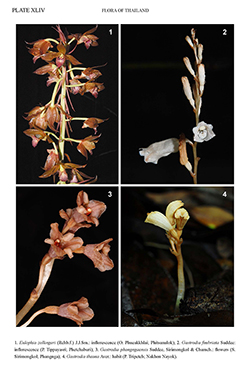e-Flora of Thailand
Volume 12 > Part 2 > Year 2014 > Page 524 > Orchidaceae > Eulophia
14. Eulophia zollingeri (Rchb.f.) J.J.Sm.wfo-0000960380
Orchid. Java: 228. 1905; Seidenf. & J.J.Wood, Orchids Penins. Malays. Singap.: 539, fig. 244a–e. 1992; S.Thomas, Lindleyana 13: 199. 1998; J.B.Comber, Orchids Sumatra: 212 (incl. colour photo). 2001; N.Pearce & P.J.Cribb, Fl. Bhutan 3(3): 254. 2002; S.C.Chen et al. in Z. Wu et al. (eds), Fl. China 25: 254. 2009; Barretto et al., Wild Orchids Hong Kong: 341, fig. 284–288. 2011.— Cyrtopera zollingeri Rchb.f., Bonplandia 5: 38. 1857. Plate XLIV: 1.
Accepted Name : This is currently accepted.
Synonyms & Citations :
Description : Plant with an underground rhizome. Rhizome horizontal, fleshy, 7–16 cm long, 1.5–2.5 cm in diameter. Foliage leaves never recorded in Thailand. Inflorescence stout, racemose, 38–74 cm tall, dense to fairly lax, 13- to many-flowered; peduncle purplish-red to yellowish-brown or greenish, 21–47 cm long; floral bracts shorter than, equal to or longer than ovaries. Flowers suberect to nodding, opening widely, dull purplish-red to brownish-yellow. Sepals acuminate; dorsal sepal elliptic, 15–22.4 by 7–11.3 mm; lateral sepals obliquely oblong, 18–24.7 by 5.8–11.5 mm. Petals obliquely obovate, obtuse to acuminate, 12–17.6 by 7–11.1 mm, glabrous. Labellum 3-lobed, 14.8–19 by 14.8–19.8 mm when flattened, widest across side lobes, with a sac-like spur at base, more or less continuously pubescent on ventral surface (except for the marginal zone); mid-lobe (triangular-)semielliptic, obtuse to acute or subacuminate, margins straight to slightly undulate; ornaments of 2 keels extending from spur or proximal part of disk to mid-lobe, in central part of disk raising to form distinct ridges (1–5 other longitudinal veins may be slightly thickened); spur obliquely conical, 4.5–5.8 mm long. Column 7–7.7 mm long; column foot slightly to distinctly shorter than column proper, not forming a spur. Ovary (including pedicel) 12–23 mm long. Capsule not seen.
Thailand : NORTH-EASTERN: Phetchabun (Nam Nao); SOUTH-WESTERN: Phetchaburi (Kaeng Krachan); CENTRAL: Nakhon Nayok (Khao Yai); SOUTH-EASTERN: Chon Buri (Si Racha); PENINSULAR: Yala.
Distribution : Sri Lanka, India, Myanmar, Vietnam, S & SE China, Taiwan, Japan and across Malesia (widespread, type from Java) to Queensland.
Ecology : Tropical rain forests, seasonal evergreen forests and once recorded from a rubber plantation with bamboo, 200–950 m alt. Flowering: April–June.
Vernacular : Wan ueng huai kha khaeng (ว่านอึ่งห้วยขาแข้ง), ueng phanoen thung (อึ่งพะเนินทุ่ง).
Notes: Normally, Eulophia zollingeri has been considered consistently mycoheterotrophic; details on its highly specialized mycorrhizal associations can be found in Ogura-Tsujita & Yukawa (2008) – based on studies of material from Myanmar, Taiwan and Japan.
Eulophia zollingerioides was described by O’Byrne (2011a). He considered his new species endemic to Peninsular Malaysia and to differ from the morphologically very similar E. zollingeri in containing chlorophyll in the roots, rhizomes and peduncle, in (consequently?) achieving a greater maximum size and in occasionally producing leafy shoots. However, whereas published illustrations of E. zollingeri from Sumatra and Java consistently show plants without any trace of green (e.g. Comber, 1990: 374; 2001: 212), evidently chlorophyll-containing plants have been illustrated from Hong Kong (Barretto et al., 2011: fig. 284, 285, 288) and Thailand (Sitthisajjadham, 2006: 262–263; misidentified as E. bicallosa). These plants match the description of E. zollingerioides and demonstrate that chlorophyll-containing members of the complex are not restricted to Peninsular Malaysia. To me, it seems questionable whether presence versus (total?) absence of chlorophyll and the apparently differing ability to (occasionally) produce leafy shoots, justify the recognition of distinct species. Therefore, I have preferred to tentatively treat E. zollingerioides as a synonym of E. zollingeri, admitting that further studies are required before a firm conclusion can be drawn.
Ormerod (2004) was the first to report Eulophia zollingeri from Thailand, based on a collection from 1923. I have seen no herbarium specimen from Phetchabun or Nakhon Nayok; the above record from Phetchabun is based on Tokaew & Chantaranothai (2009), whereas the record from Nakhon Nayok is based on Amonrat Buakhlai’s unpublished M.Sc. Thesis on the “Diversity of orchids at Khao Khiao area in Khao Yai National Park” (Department of Botany, Chulalongkorn University, 2005). A line drawing and a colour photo in the thesis reveal that the reported find of E. macrobulbon is actually referable to E. zollingeri. This observation furthermore questions the reliability of an earlier record of E. macrobulbon (C.S.P.Parish & Rchb.f.) Hook.f. from Khao Yai (Cumberlege & Cumberlege 1963); I have not been able to retrieve the collection cited in that paper (Cumberlege 748).

